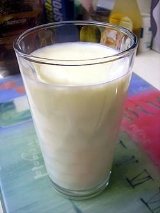
Milk
Overview
Milk is a white liquid produced by the mammary gland
s of mammal
s. It is the primary source of nutrition
for young mammals before they are able to digest
other types of food. Early-lactation
milk contains colostrum
, which carries the mother's antibodies
to the baby and can reduce the risk of many diseases in the baby.
Milk derived from cattle species is an important food. It has many nutrients. The precise nutrient composition of raw milk
vary by species and by a number of other factors, but it contains significant amounts of saturated fat
, protein
and calcium
as well as vitamin C
.
Mammary gland
A mammary gland is an organ in mammals that produces milk to feed young offspring. Mammals get their name from the word "mammary". In ruminants such as cows, goats, and deer, the mammary glands are contained in their udders...
s of mammal
Mammal
Mammals are members of a class of air-breathing vertebrate animals characterised by the possession of endothermy, hair, three middle ear bones, and mammary glands functional in mothers with young...
s. It is the primary source of nutrition
Nutrition
Nutrition is the provision, to cells and organisms, of the materials necessary to support life. Many common health problems can be prevented or alleviated with a healthy diet....
for young mammals before they are able to digest
Digestion
Digestion is the mechanical and chemical breakdown of food into smaller components that are more easily absorbed into a blood stream, for instance. Digestion is a form of catabolism: a breakdown of large food molecules to smaller ones....
other types of food. Early-lactation
Lactation
Lactation describes the secretion of milk from the mammary glands and the period of time that a mother lactates to feed her young. The process occurs in all female mammals, however it predates mammals. In humans the process of feeding milk is called breastfeeding or nursing...
milk contains colostrum
Colostrum
Colostrum is a form of milk produced by the mammary glands of mammals in late pregnancy. Most species will generate colostrum just prior to giving birth...
, which carries the mother's antibodies
Antibody
An antibody, also known as an immunoglobulin, is a large Y-shaped protein used by the immune system to identify and neutralize foreign objects such as bacteria and viruses. The antibody recognizes a unique part of the foreign target, termed an antigen...
to the baby and can reduce the risk of many diseases in the baby.
Milk derived from cattle species is an important food. It has many nutrients. The precise nutrient composition of raw milk
Raw milk
Raw milk is milk that has not been pasteurized or homogenized.-History:Humans consumed raw milk exclusively prior to the industrial revolution and the invention of the pasteurization process in 1864. During the industrial revolution large populations congregated into urban areas detached from the...
vary by species and by a number of other factors, but it contains significant amounts of saturated fat
Saturated fat
Saturated fat is fat that consists of triglycerides containing only saturated fatty acids. Saturated fatty acids have no double bonds between the individual carbon atoms of the fatty acid chain. That is, the chain of carbon atoms is fully "saturated" with hydrogen atoms...
, protein
Protein
Proteins are biochemical compounds consisting of one or more polypeptides typically folded into a globular or fibrous form, facilitating a biological function. A polypeptide is a single linear polymer chain of amino acids bonded together by peptide bonds between the carboxyl and amino groups of...
and calcium
Calcium
Calcium is the chemical element with the symbol Ca and atomic number 20. It has an atomic mass of 40.078 amu. Calcium is a soft gray alkaline earth metal, and is the fifth-most-abundant element by mass in the Earth's crust...
as well as vitamin C
Vitamin C
Vitamin C or L-ascorbic acid or L-ascorbate is an essential nutrient for humans and certain other animal species. In living organisms ascorbate acts as an antioxidant by protecting the body against oxidative stress...
.

